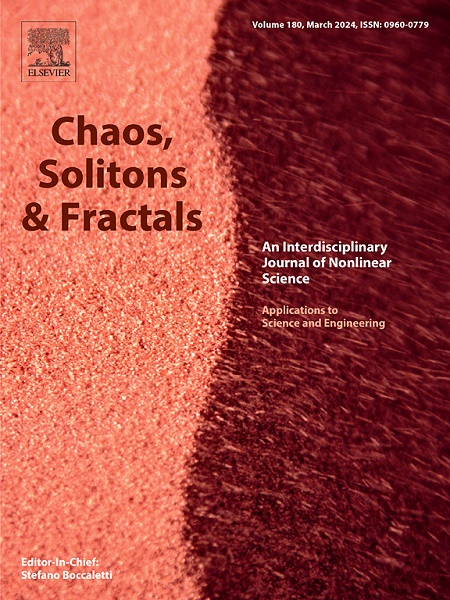Improved energy-adaptive coupling for synchronization of neurons with nonlinear and memristive membranes
IF 5.6
1区 数学
Q1 MATHEMATICS, INTERDISCIPLINARY APPLICATIONS
引用次数: 0
Abstract
Synaptic connections in neural systems can be adaptively regulated through the exchange of field energy between neurons. This paper investigates the energy-based adaptive coupling mechanism in the context of two neuron models: a nonlinear membrane model and a memristive membrane model. Both models are examined under various external and intrinsic conditions, revealing rich dynamical behaviors including periodic, quasi-periodic, and chaotic firing patterns, as well as multistability. An energy-based adaptive coupling strategy, based on a threshold-triggered adjustment of coupling intensity driven by energy diversity, has been previously introduced for reaching synchronization and energy balance in neurons. Here, we enhance this adaptive coupling to incorporate the hyperbolic tangent of the energy difference relative to a threshold. This smooth, bounded function allows the coupling intensity to evolve more robustly and precisely. Synchronization is analyzed for both models using both the original and proposed adaptive coupling strategy by computing the synchronization factor across parameter sets. Comparative simulations demonstrate that the proposed coupling strategy yields improved synchronization performance in both pairs of neurons and ring network configurations. The enhanced coupling consistently achieves higher synchronization factors, faster convergence, and greater robustness across complex dynamical regimes.
具有非线性和记忆膜的神经元同步的改进能量自适应耦合
神经系统中的突触连接可以通过神经元之间的电场能量交换进行自适应调节。本文在非线性膜模型和记忆膜模型两种神经元模型的背景下研究了基于能量的自适应耦合机制。这两个模型在各种外部和内部条件下进行了测试,揭示了丰富的动力学行为,包括周期,准周期和混沌发射模式,以及多稳定性。一种基于能量的自适应耦合策略,基于能量多样性驱动的阈值触发的耦合强度调节,已被引入以达到神经元的同步和能量平衡。在这里,我们增强了这种自适应耦合,以结合相对于阈值的能量差的双曲正切。这种光滑的有界函数允许耦合强度更加稳健和精确地演化。通过计算跨参数集的同步因子,对两种模型分别采用原自适应耦合策略和提出的自适应耦合策略进行同步分析。仿真结果表明,所提出的耦合策略在神经元对和环形网络配置下均能提高同步性能。增强的耦合在复杂的动态体系中始终实现更高的同步因子、更快的收敛和更强的鲁棒性。
本文章由计算机程序翻译,如有差异,请以英文原文为准。
求助全文
约1分钟内获得全文
求助全文
来源期刊

Chaos Solitons & Fractals
物理-数学跨学科应用
CiteScore
13.20
自引率
10.30%
发文量
1087
审稿时长
9 months
期刊介绍:
Chaos, Solitons & Fractals strives to establish itself as a premier journal in the interdisciplinary realm of Nonlinear Science, Non-equilibrium, and Complex Phenomena. It welcomes submissions covering a broad spectrum of topics within this field, including dynamics, non-equilibrium processes in physics, chemistry, and geophysics, complex matter and networks, mathematical models, computational biology, applications to quantum and mesoscopic phenomena, fluctuations and random processes, self-organization, and social phenomena.
 求助内容:
求助内容: 应助结果提醒方式:
应助结果提醒方式:


